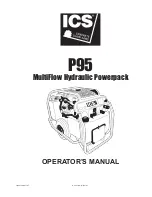
English
57
7. How to use the LED light
Every time you press the light switch on the switch
panel, the LED light lights or goes off. (
Fig. 14
)
To prevent the battery power consumption, turn off
the LED light frequently.
CAUTION:
䡬
Do not expose directly your eye to the light by looking
into the light.
If your eye is continuously exposed to the light, your
eye will be hurt.
NOTE:
䡬
To prevent the battery power consumption caused
by forgetting to turn off the LED light, the light goes
off automatically in about 15 minutes.
OPERATIONAL CAUTIONS
1. Resting the unit after continuous work
After use for continuous bolt-tightening work, rest
the unit for 15 minutes or so when replacing the
battery. The temperature of the motor, switch, etc.,
will rise if the work is started again immediately after
battery replacement, eventually resulting in burnout.
NOTE:
Do not touch the protector, as it gets very hot during
continuous work.
2. Cautions on use of the speed control switch
This switch has a built-in, electronic circuit which
steplessly varies the rotation speed. Consequently,
when the switch trigger is pulled only slightly (low
speed rotation) and the motor is stopped while
continuously driving in screws, the components of
the electronic circuit parts may overheat and be
damaged.
3. Tightening torque
Refer to
Fig. 19
for the tightening torque of bolts
(according to size), under the conditions shown in
Fig. 20
. Please use this example as a general reference,
as tightening torque will vary according to tightening
conditions.
NOTE:
䡬
If a long striking time is used, screws will be strongly
tightened. This may cause the screw to break, or may
damage the tip of the bit.
䡬
If the unit is held at an angle to the screw being
tightened, the head of the screw may be damaged, or
the specified torque may not be transmitted to the
screw. Always keep the unit and the screw being
tightened in a straight line.
4. Use a tightening time suitable for the screw
The appropriate torque for a screw differs according
to the material and size of the screw, and the material
being screwed etc., so please use a tightening time
suitable for the screw. In particular, if a long tightening
time is used in the case of screws smaller than M8,
there is a danger of the screw breaking, so please
confirm the tightening time and the tightening torque
beforehand.
5. Work at a tightening torque suitable for the bolt
under impact
The optimum tightening torque for nuts or bolts
differs with material and size of the nuts or bolts. An
excessively large tightening torque for a small bolt
may stretch or break the bolt. The tightening torque
increases in proportion to the operaton time. Use the
correct operating time for the bolt.
6. Holding the tool
Hold the impact wrench firmly with both hands. In
this case hold the wrench in line with the bolt.
It is not necessary to push the wrench very hard.
Hold the wrench with a force just sufficient to
counteract the impact force.
7. Confirm the tightening torque
The following factors contribute to a reduction of the
tightening torque. So confirm the actual tightening
torque needed by screwing up some bolts before the
job with a hand torque wrench. Factors affecting the
tightening torque are as follows.
(1) Voltage
When the discharge margin is reached, voltage
decreases and tightening torque is lowered.
(2) Operating time
The tightening torque increases when the operating
time increases. But the tightening torque does not
increase above a certain value even if the tool is
driven for a long time. (See
Fig. 19
)
(3) Diameter of bolt
The tightening torque differs with the diameter of the
bolt as shown in
Fig. 19.
Generally a larger diameter
bolt requires larger tightening torque.
(4) Tightening conditions
The tightening torque differs according to the torque
ratio; class, and length of bolts even when bolts with
the same size threads are used. The tightening torque
also differs according to the condition of the surface
of workpiece through which the bolts are to be
tightened. When the bolt and nut turn together, torque
is greatly reduced.
(5) Using optional parts
The tightening torque is reduced a little when an
extension bar, universal joint or a long socket is
used.
(6) Clearance of the socket
A worn or deformed hex. or a square-holed socket
will not give an adequate tightness to the fitting
between the nut or anvil, consequently resulting in
loss of tightening torque.
Using an improper socket which does not match to
the bolt will result in an insufficient tightening torque.
Matching socket and bolt sizes are shown in
Table 1
and
2
.
(7) Tightening torque varies, depending on the battery’s
charge level.
Fig. 21
show examples of the relationship between
tightening torque and the number of tightenings, for
WR14DSL. As shown, tightening torque gradually
weakens with the increase in the number of
tightenings. In particular, as the torque decreases
very close to the complete discharge (“a” margin in
graph), the unit’s impact weakens, the number of
time impacts declines and tightening torque drops
off abruptly. If this occurs, check torque level, then
recharge the battery if necessary.
05Eng_WR14DSL_NE
6/20/08, 10:02
57
Содержание WR 14DSL
Страница 62: ...61 06Back_WR14DSL_NE 6 20 08 10 02 61 ...







































